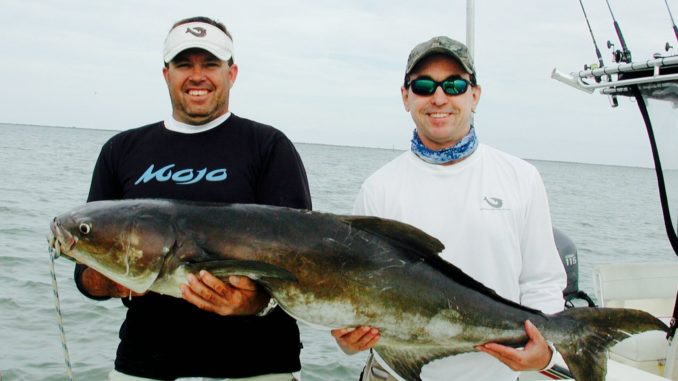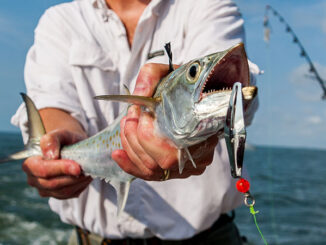
Cobia, Spanish team up at Cape Lookout
If anglers want to catch cobia this spring, they might consider looking for Spanish mackerel. At least that’s what veteran guide Noah Lynk of Harkers Island suggests.
“You can sight-fish for cobia around buoys or bottom-fish like you would for sharks, but I’ve caught more cobias while Spanish fishing,” said Lynk (252-342-6911), who expects mild winter and spring weather to put cobia and Spanish mackerel together off Cape Lookout through May and into June.
To sight-fish, Lynk searches for menhaden bait balls near the surface because Spanish mackerel love to feed around them. He’ll keep several heavier rods ready to pitch artificials or live bait to any cobia he sees.
Last year, Lynk developed a cobia lure for Salty Bay called a Slammer, which comes in 6- and 8-inch lengths, has belly ribs and a paddletail. Colors include black-gray, purple-white, blue-white and brown-beige.
“But I’ll put 10 or 15 (menhaden) in my bait well so I can cast and free-line a live bait,” Lynk said.
When he sees a large school of menhaden being slashed by Spanish mackerel, Lynk will motor near the edge of the melee, where he often spots cobia.
“I can throw a stunned shad at a cobia, and they’ll jump all over it,” said Lynk, who climbs a spotting tower above his boat’s center console and wears polarized sunglasses.
“When I see a big school (of menhaden), I climb the tower,” he said. “People fishing often have a half-dozen cobia near them but can’t see them.”
Lynk said cobia can be either at the surface or on the bottom.
“If I’m targeting them on top, I’ll basically sight-fish, running from bait pod to bait pod, from Beaufort Inlet to the Cape (Lookout) shoals and all down the East Side,” he said. “Cobia love buoys, and Beaufort Inlet has tons of buoys.”
Cobia found around buoys will often chase bucktails.
“I’ll use bucktails with an eel or twister-tail attached,” Lynk said. “They like pinks, purple, blue and orange colors.”
Lynk spools his casting reels with 30-pound braid and uses a 50- to 60-pound leader.
“I like 6 or 7 feet of leader in case a fish decides to spin or wrap so his gill plates can’t cut the line,” Lynk said.
For bottom-fishing, he uses a tarpon-sized fish-finder rig.
North Carolina anglers had better take advantage of May action, with the season closing June 20 this year and the creel limit down to one fish per day.



Be the first to comment